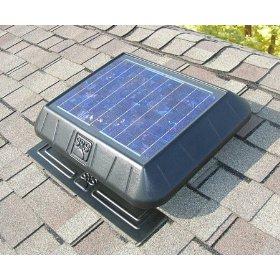
Solar attic fans are used for ventilation and run solely off solar power. Ventilation occurs as the fan forces outside air through the attic and out a vent.
Attics Without Proper Ventilation
No matter what time of year it is, radiant heat from the sun is absorbed by the tiles or shingles on your home all day long. Summer months it's worse because we have more hours of sunlight. Insulation makes a difference in keeping the heat out, but it only slows the process. It doesn't stop it completely. As a result, attic air can reach temperatures of 140-160 F. This heat works through your insulation and into your home, where it forces the air conditioner to compensate to keep your home comfortable. When your air conditioner works harder to keep up with the extra heat, your energy bills are higher.
Passive Draft Vents
Most attics are vented which allows hot air to rise and flow out of the vents. While these vents do create air flow, they don't do anything about reducing the attic temperature. Even turbine vents which pull hot air from the attic when the wind blows don't do the job of reducing attic temperatures most of the time. While the turbine vents aren't really passive, they often experience mechanical problems, and on a sultry summer day when there is no breeze, the turbines do nothing and the attic heats up. Passive draft vents include:
- Dormer vents
- Gable vents
- Ridge vents
The question on most people's minds when planning to install solar attic fans is whether or not these passive venting systems will in anyway interfere with the operation of the solar powered attic fans once they are installed. Current vents should be taken into consideration when installing solar fans. In the case of ridge vents, once the solar fan is installed, they will work in reverse. Instead of being a means for air to escape they will be used to draw in fresh air when the solar fan is running. It does take extra care in placing your solar fan vent unit in conjunction with ridge vents. If you are planning to install your solar powered attic fans yourself, be sure to check with the manufacturer for recommendations for placement in conjunction with ridge vents.
For Turbine vents, most of the time solar attic vent units can be installed as replacements to the existing turbine vents. This may require cutting a bigger hole to accommodate the new vent. Make sure your installer is knowledgeable and experienced. If you plan to do it yourself, line up the proper tools before you start the project.
Benefits of Installing Solar Attic Fans
If your attic is vented to allow air to naturally flow through the space above your home, you may wonder what benefits are derived from installing solar powered attic fans. The benefits in regards to energy savings have to do with the fact that solar powered attic fans reduce the temperature in your attic. The benefits in general include:
- They're quiet
- Reduces attic air temperature
- Heat transferred into your living space is minimized
- Saves energy and money because the air conditioner doesn't have to work as hard.
How Much Money Will You Save?
Installing a solar attic fan will reduce the amount of energy you use, but just how much money you will save depends on the following:
- Cost of electricity in your area,
- Size of your attic space
- Efficiency of insulation in your attic
- How much ventilation your solar attic fan provides
The benefit of "solar" attic vent units is that they run when the sun is out. It is unlikely to matter that they don't work when the sun isn't shining as an attic won't require cooling on an overcast day. In most cases, the savings you'll enjoy will pay for your solar powered attic fans within a couple of summers.







